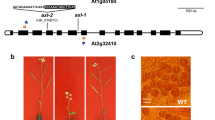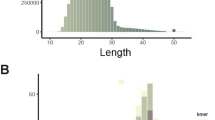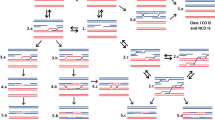Abstract
Arabidopsis thaliana CENTRIN2 (AtCEN2) has been shown to modulate Nucleotide Excision Repair (NER) and Homologous Recombination (HR). The present study provides evidence that AtCEN2 interacts with the Arabidopsis homolog of human XPC, AtRAD4 and that the distal EF-hand Ca2+ binding domain is essential for this interaction. In addition, the synthesis-dependent repair efficiency of bulky DNA lesions was enhanced in cell extracts prepared from Arabidopsis plants overexpressing the full length AtCEN2 but not in those overexpressing a truncated AtCEN2 form, suggesting a role for the distal EF-hand Ca2+ binding domain in the early step of the NER process. Upon UV-C treatment the AtCEN2 protein was shown to be increased in concentration and to be localised in the nucleus rapidly. Taken together these data suggest that AtCEN2 is a part of the AtRAD4 recognition complex and that this interaction is required for efficient NER. In addition, NER and HR appear to be differentially modulated upon exposure of plants to DNA damaging agents. This suggests in plants, that processing of bulky DNA lesions highly depends on the excision repair efficiency, especially the recognition step, thus influencing the recombinational repair pathway.
Similar content being viewed by others
Abbreviations
- BER:
-
Base Excision Repair
- DSB:
-
Double Strand Break
- GFP:
-
Green Fluorescent Protein
- HR:
-
Homologous Recombination
- ICL:
-
Inter/Intra Crosslink
- NHEJ:
-
Non Homologous End Joining
- NER:
-
Nucleotide Excision Repair
- MMR:
-
Mismatch Repair
- XP:
-
Xeroderma Pigmentosum
References
M. Araki C. Masutani M. Takemura A. Uchida K. Sugasawa J. Kondoh Y. Ohkuma F. Hanaoka (2001) ArticleTitleCentrosome Protein Centrin 2/Caltractin 1 Is Part of the Xeroderma Pigmentosum Group C Complex That Initiates Global Genome Nucleotide Excision Repair J. Biol.Chem. 276 18665–18672 Occurrence Handle11279143 Occurrence Handle1:CAS:528:DC%2BD3MXkt12ktrg%3D Occurrence Handle10.1074/jbc.M100855200
A.B. Britt (1999) ArticleTitleMolecular genetics of DNA repair in higher plants Trends Plant Sci. 4 20–24 Occurrence Handle10234266 Occurrence Handle10.1016/S1360-1385(98)01355-7
R.S. Cole R.R. Sinden (1975) ArticleTitleRepair of cross-linked DNA in Escherichia coli Basic Life Sci. 5 487–495
R.M. Costa V. Chigancas S. Galhardo Rda H. Carvalho C.F. Menck (2003) ArticleTitleThe eukaryotic nucleotide excision repair pathway Biochimie 85 1083–1099 Occurrence Handle14726015 Occurrence Handle1:CAS:528:DC%2BD2cXjsVyrtw%3D%3D Occurrence Handle10.1016/j.biochi.2003.10.017
I.U. Silva ParticleDe P.J. McHugh P.H. Clingen J.A. Hartley (2000) ArticleTitleDefining the role of nucleotide excision repair and recombination in the repair of DNA interstrand cross-links in mammalian cells Mol. Cell. Biol. 20 7980–7990 Occurrence Handle11027268 Occurrence Handle10.1128/MCB.20.21.7980-7990.2000
S. Dubest M.E. Gallego C.I. White (2004) ArticleTitleRoles of the AtErcc1 protein in recombination Plant J. 39 334–342 Occurrence Handle15255863 Occurrence Handle1:CAS:528:DC%2BD2cXnsVSqurg%3D Occurrence Handle10.1111/j.1365-313X.2004.02136.x
I. Durussel Y. Blouquit S. Middendorp C.T. Craescu J.A. Cox (2000) ArticleTitleCation- and peptide-binding properties of human centrin 2 FEBS Lett. 472 208–212 Occurrence Handle10788612 Occurrence Handle1:CAS:528:DC%2BD3cXislartrc%3D Occurrence Handle10.1016/S0014-5793(00)01452-6
B. Elliott M. Jasin (2001) ArticleTitleRepair of double-strand breaks by homologous recombination in mismatch repair-defective mammalian cells Mol. Cell. Biol. 21 2671–2682 Occurrence Handle11283247 Occurrence Handle1:CAS:528:DC%2BD3MXisVyhsLg%3D Occurrence Handle10.1128/MCB.21.8.2671-2682.2001
A. Ferrando Z. Koncz-Kalman R. Farras A. Tiburcio J. Schell C. Koncz (2001) ArticleTitleDetection of in vivo protein interactions between Snf1-related kinase subunits with intron-tagged epitope-labelling in plants cells Nucleic Acids Res. 29 3685–3693 Occurrence Handle11522840 Occurrence Handle1:CAS:528:DC%2BD3MXotlWluro%3D Occurrence Handle10.1093/nar/29.17.3685
Garinis, G.A., Mitchell, J.R., Moorhouse, M.J., Hanada, K., de Waard, H., Vandeputte, D., Jans, J., Brand, K., Smid, M., van der Spek, P.J., Hoeijmakers, J.H., Kanaar, R. and van der Horst, G.T. 2005. Transcriptome analysis reveals cyclobutane pyrimidine dimers as a major source of UV-induced DNA breaks. EMBO J. 24: 3952–3962.
H. Gherbi M.E. Gallego N. Jalut J.M. Lucht B. Hohn C.I. White (2001) ArticleTitleHomologous recombination in planta is stimulated in the absence of Rad50 EMBO Rep. 2 287–291 Occurrence Handle11306548 Occurrence Handle1:CAS:528:DC%2BD3MXks1Cqtbw%3D Occurrence Handle10.1093/embo-reports/kve069
C.A. Hendricks M. Razlog T. Matsuguchi A. Goyal A.L. Brock B.P. Engelward (2002) ArticleTitleThe S. cerevisiae Mag1 3-methyladenine DNA glycosylase modulates susceptibility to homologous recombination DNA Repair 1 645–659 Occurrence Handle12509287 Occurrence Handle1:CAS:528:DC%2BD38XmsFOgt7w%3D Occurrence Handle10.1016/S1568-7864(02)00072-1
T. Hey G. Lipps K. Sugasawa S. Iwai F. Hanaoka G. Krauss (2002) ArticleTitleXPC-HR23B complex displays high affinity and specificity for damaged DNA in a true-equilibrium fluorescence assay Biochemistry 41 6583–6587 Occurrence Handle12022861 Occurrence Handle1:CAS:528:DC%2BD38Xjt1Krs7s%3D Occurrence Handle10.1021/bi012202t
W.J. Jachymczyk R.C. Borstel Particlevon M.R. Mowat P.J. Hastings (1981) ArticleTitleRepair of interstrand cross-links in DNA of Saccharomyces cerevisiae requires two systems for DNA repair: the RAD3 system and the RAD51 system Mol. Gen. Genet. 182 196–205 Occurrence Handle7026973 Occurrence Handle1:CAS:528:DyaL3MXltFWmtbc%3D Occurrence Handle10.1007/BF00269658
S. Kimura Y. Tahira T. Ishibashi Y. Mori T. Mori J. Hashimoto K. Sakaguchi (2004) ArticleTitleDNA repair in higher plants; photoreactivation is the major DNA repair pathway in non-proliferating cells while excision repair (nucleotide excision repair and base excision repair) is active in proliferating cells Nucleic Acids Res. 32 2760–2767 Occurrence Handle15150342 Occurrence Handle1:CAS:528:DC%2BD2cXksVahsr4%3D Occurrence Handle10.1093/nar/gkh591
W.L. Laat Particlede N.G. Jaspers J.H. Hoeijmakers (1999) ArticleTitleMolecular mechanism of nucleotide excision repair Genes Dev. 13 768–785 Occurrence Handle10197977
A.R. Lehmann (2003) ArticleTitleDNA repair-deficient diseases, xeroderma pigmentosum, Cockayne syndrome and trichothiodystrophy Biochimie 85 1101–1111 Occurrence Handle14726016 Occurrence Handle1:CAS:528:DC%2BD2cXjsVyrtA%3D%3D Occurrence Handle10.1016/j.biochi.2003.09.010
A. Li D. Schuermann F. Gallego I. Kovalchuk B. Tinland (2002) ArticleTitleRepair of damaged DNA by Arabidopsis cell extract Plant Cell 14 263–273 Occurrence Handle11826311 Occurrence Handle1:CAS:528:DC%2BD38Xht1Srtrk%3D Occurrence Handle10.1105/tpc.010258
F. Liang M. Han P.J. Romanienko M. Jasin (1998) ArticleTitleHomology-directed repair is a major double-strand break repair pathway in mammalian cells Proc. Natl. Acad. Sci. USA 95 5172–5177 Occurrence Handle9560248 Occurrence Handle1:CAS:528:DyaK1cXivV2jtr4%3D Occurrence Handle10.1073/pnas.95.9.5172
E. Matei S. Miron Y. Blouquit P. Duchambon I. Durussel J.A. Cox C.T. Craescu (2003) ArticleTitleC-Terminal Half of Human Centrin 2 Behaves like a Regulatory EF-Hand Domain Biochemistry 42 1439–1450 Occurrence Handle12578356 Occurrence Handle1:CAS:528:DC%2BD3sXotVKnug%3D%3D Occurrence Handle10.1021/bi0269714
P.J. McHugh V.J. Spanswick J.A. Hartley (2001) ArticleTitleRepair of DNA interstrand crosslinks: molecular mechanisms and clinical relevance Lancet Oncol. 2 483–490 Occurrence Handle11905724 Occurrence Handle1:CAS:528:DC%2BD3MXms1ehsrs%3D Occurrence Handle10.1016/S1470-2045(01)00454-5
J. Molinier C. Ramos O. Fritsch B. Hohn (2004) ArticleTitleCENTRIN2 modulates homologous recombination and nucleotide excision repair in Arabidopsis Plant Cell 16 1633–1643 Occurrence Handle15155891 Occurrence Handle1:CAS:528:DC%2BD2cXlsFWlsbY%3D Occurrence Handle10.1105/tpc.021378
J.M.Y. Ng W. Vermeulen G.T.J. Horst Particlevan der S. Bergink K. Sugasawa H. Vrieling J.H.J. Hoeijmakers (2003) ArticleTitleA novel regulation mechanism of DNA repair by damage-induced and RAD23-dependent stabilization of xeroderma pigmentosum group C protein Genes Dev. 17 1630–1645 Occurrence Handle12815074 Occurrence Handle1:CAS:528:DC%2BD3sXlsV2ru7o%3D Occurrence Handle10.1101/gad.260003
R. Nishi Y. Okuda E. Watanabe T. Mori S. Iwai C. Masutani K. Sugasawa F. Hanaoka (2005) ArticleTitleCentrin 2 stimulates nucleotide excision repair by interacting with xeroderma pigmentosum group C protein Mol Cell Biol. 13 5664–5674 Occurrence Handle10.1128/MCB.25.13.5664-5674.2005 Occurrence Handle1:CAS:528:DC%2BD2MXlslCjt7k%3D
Y. Okuda R. Nishi J.M. Ng W. Vermeulen G.T. Horst Particlevan der T. Mori J.H. Hoeijmakers F. Hanaoka K. Sugasawa (2004) ArticleTitleRelative levels of the two mammalian Rad23 homologs determine composition and stability of the xeroderma pigmentosum group C protein complex DNA Repair 3 1285–1295 Occurrence Handle15336624 Occurrence Handle1:CAS:528:DC%2BD2cXntFSmsrw%3D Occurrence Handle10.1016/j.dnarep.2004.06.010
F. Paques J.E. Haber (1999) ArticleTitleMultiple pathways of recombination induced by double-strand break in Saccharomyces cerevisiae Microbiol. Mol. Biol. Rev. 63 349–404 Occurrence Handle10357855 Occurrence Handle1:STN:280:DyaK1M3os1eksA%3D%3D
A. Popescu S. Miron Y. Blouquit P. Duchambon P. Christova C. T. Craescu (2003) ArticleTitleXeroderma Pigmentosum Group C Protein Possesses a High Affinity Binding Site to Human Centrin 2 and Calmodulin J. Biol. Chem. 278 40252–40261 Occurrence Handle12890685 Occurrence Handle1:CAS:528:DC%2BD3sXnvFamtrk%3D Occurrence Handle10.1074/jbc.M302546200
H. Puchta B. Hohn (1996) ArticleTitleFrom centimorgans to base pairs: homologous recombination in plants Trends Plant Sci. 1 340–348
G. Ries W. Heller H. Puchta H. Sandermann H.K. Seidlitz B. Hohn (2000) ArticleTitleElevated UV-B radiation reduces genome stability in plants Nature 406 98–101 Occurrence Handle10894550 Occurrence Handle1:CAS:528:DC%2BD3cXlt12qsLw%3D Occurrence Handle10.1038/35017595
W. A. Saffran S. Ahmed S. Bellevue G. Pereira T. Patrick W. Sanchez S. Thomas M. Alberti J.E. Hearst (2004) ArticleTitleDNA repair defects channel interstrand DNA crosslinks into alternate recombinational and error-prone repair pathways J. Biol. Chem. 279 36462–36469 Occurrence Handle15213235 Occurrence Handle1:CAS:528:DC%2BD2cXmvFCnu7w%3D Occurrence Handle10.1074/jbc.M402323200
J.L. Salisbury (1995) ArticleTitleCentrin, centrosomes, and mitotic spindle poles Curr. Opin. Cell Biol. 7 39–45 Occurrence Handle7755988 Occurrence Handle1:CAS:528:DyaK2MXjsVyktr0%3D Occurrence Handle10.1016/0955-0674(95)80043-3
C. Schauber L. Chen P. Tongaonkar I. Vega D. Lambertson W. Potts K. Madura (1998) ArticleTitleRad23 links DNA repair to the ubiquitin/proteasome pathway Nature 391 715–718 Occurrence Handle9490418 Occurrence Handle1:CAS:528:DyaK1cXht1Knu78%3D Occurrence Handle10.1038/35661
M. Tourbez C. Firanescu A. Yang L. Unipan P. Duchambon Y. Blouquit C.T. Craescu (2004) ArticleTitleCalcium-dependent self-assembly of human centrin 2 J. Biol. Chem. 279 47672–47680 Occurrence Handle15356003 Occurrence Handle1:CAS:528:DC%2BD2cXptl2gurc%3D Occurrence Handle10.1074/jbc.M404996200
A. Uchida K. Sugasawa C. Masutani N. Dohmae M. Araki M. Yokoi Y. Ohkuma F. Hanaoka (2002) ArticleTitleThe carboxy-terminal domain of the XPC protein plays a crucial role in nucleotide excision repair through interactions with transcription factor IIH DNA Repair 1 449–461 Occurrence Handle12509233 Occurrence Handle1:CAS:528:DC%2BD38XntlOhu7w%3D Occurrence Handle10.1016/S1568-7864(02)00031-9
J.F. Villemure C. Abaji I. Cousineau A. Belmaaza (2003) ArticleTitleMSH2-deficient human cells exhibit a defect in the accurate termination of homology-directed repair of DNA double-strand breaks Cancer Res. 63 3334–3339 Occurrence Handle12810667 Occurrence Handle1:CAS:528:DC%2BD3sXks1ehsro%3D
E.J. Vonarx H.L. Mitchell R. Karthikeyan I. Chatterjee B.A. Kunz (1998) ArticleTitleDNA repair in higher plants Mutat. Res. 400 187–200 Occurrence Handle9685637 Occurrence Handle1:CAS:528:DyaK1cXks1OnsrY%3D
G. Wang A. Dombkowski L. Chuang X.X. Xu (2004a) ArticleTitleThe involvement of XPC protein in the Cisplatin DNA damaging treatment-mediated cellular response Cell Res. 14 303–314 Occurrence Handle1:CAS:528:DC%2BD2cXoslGgt7g%3D Occurrence Handle10.1038/sj.cr.7290375
G. Wang L. Chuang X. Zhang S. Colton A. Dombkowski J. Reiners A. Diakiw X.S. Xu (2004b) ArticleTitleThe initiative role of XPC protein in Cisplatin DNA damaging treatment-mediated cell cycle regulation Nucleic Acids Res. 32 2231–2240 Occurrence Handle1:CAS:528:DC%2BD2cXjsVers7k%3D Occurrence Handle10.1093/nar/gkh541
J.S. You M. Wang S.H. Lee (2003) ArticleTitleBiochemical analysis of the damage recognition process in nucleotide excision repair J. Biol. Chem. 278 7476–7485 Occurrence Handle12486030 Occurrence Handle1:CAS:528:DC%2BD3sXhsVKitLs%3D Occurrence Handle10.1074/jbc.M210603200
Author information
Authors and Affiliations
Corresponding author
Rights and permissions
About this article
Cite this article
Liang, L., Flury, S., Kalck, V. et al. CENTRIN2 Interacts with the Arabidopsis Homolog of the Human XPC Protein (AtRAD4) and Contributes to Efficient Synthesis-dependent Repair of Bulky DNA Lesions. Plant Mol Biol 61, 345–356 (2006). https://doi.org/10.1007/s11103-006-0016-9
Received:
Accepted:
Issue Date:
DOI: https://doi.org/10.1007/s11103-006-0016-9




